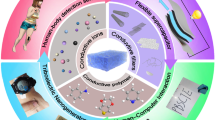Abstract
The thermal history of amorphous polymers near the glass-transition temperature determines the extent to which macromolecules structurally relax, and ultimately their properties. Here, we report the correlation between physical aging, dielectric breakdown, and capacitive energy storage of polystyrene, poly(methyl-methacrylate), and associated silica nanocomposites. Guided by enthalphic recovery rates, dielectric breakdown strength increased from 20% to 40% when aged at Tg−10 °C before use. The generality of improvement and connection to enthalpic recovery afford a means to design pre-service processing of new polymers and additive manufacturing techniques to reduce excess volume within the glass; and thereby reduce initiation and inhibit propagation of electronic failure.





Similar content being viewed by others

References
Z.M. Dang, J.K. Yuan, S.H. Yao, and R.J. Liao: Flexible nanodielectric materials with high permittivity for power energy storage. Adv. Mater. 25, 6334–6335 2013).
Q. Wang and L. Zhu: Polymer nanocomposites for electrical energy storage. J. Polym. Sci. B, Polym. Phys. 49, 1421–1429 2011).
L.A. Dissadio and J.C. Fothergill: Electrical Degradation and Breakdown in Polymers (Peter Peregrinius Ltd., London, UK, 1992) pp. 601.
H. Sabuni and J.K. Nelson: The electric strength of copolymers. J. Mater. Sci. 12, 2435–2440 1977).
K. Wu, T. Okamoto, and Y. Suzuoki: Simulation study on the correlation between morphology and electrical breakdown in polyethylene. J. Appl. Phys. 98, 114102 (2005).
J. Artbauer: Electric strength of polymers. J. Phys. D, Appl. Phys. 29, 446–456 1996).
S.A. Paniagua, Y. Kim, K. Henry, R. Kumar, J.W. Perry, and S.R. Marder: Surface-initiated polymerization from barium titanate nanoparticles for hybrid dielectric capacitors. ACS Appl. Mater. Interface. 6, 3477–3482 2014).
J. Li, J. Claude, L.E. Norena-Franco, S.I. Seok, and Q. Wang: Electrical energy storage in ferroelectric polymer nanocomposites containing surface-functionalizedBaTiO3 nanoparticles. Chem. Mater. 20, 6304–6306 2008).
J.M. Hutchinson: Physical aging of polymers. Prog. Polym. Sci. 20, 703–760 (1995).
D. Cangialosi, V.M. Boucher, A. Alegria, and J. Colmenero: Physical aging in polymers and polymer nanocomposites: recent results and open questions. Soft Matter 9, 8619–8630 2013).
R.D. Priestley: Physical aging of confined glasses. Soft Matter 5, 919–926 (2009).
L. Vouyovitch, N.D. Alberola, L. Flandin, A. Beroual, and J.-L. Bessede: Dielectric breakdown of epoxy-based composites: relative influence of physical and chemical aging. IEEE Trans. Dielectr. Electr. Insul. 13, 282–292 2006).
J.V. Champion and S.J. Dodd: The effect of voltage and material age on the electrical tree growth and breakdown characteristics of epoxy resins. J. Phys. D, Appl. Phys. 28, 398–407 1995).
Y.P. Koh and S.L. Simon: Enthalpy recovery of polystyrene: does a longterm aging plateau exist? Macromolecules 46, 5815–5821 2013).
S.L. Simon, J.W. Sobieski, and D.J. Plazek: Volume and enthalpy recovery of polystyrene. Polymer 42, 2555–2567 2001).
J.S. Meth, S.G. Zane, C.Z. Chi, J.D. Londono, B.A. Wood, P. Cotts, M. Keating, W. Guise, and S. Weigand: Development of filler structure in colloidal silica-polymer nanocomposites. Macromolecules 44, 8301–8313 2011).
J. Pietrasik, C.M. Hui, W. Chaladaj, H. Dong, J. Choi, J. Jurczak, M.R. Bockstaller, and K. Matyjaszewski: Silica-polymethacrylate hybrid particles synthesized using high-pressure atom transfer radical polymerization. Macromol. Rapid Commun. 32, 295–311 2011).
C.A. Grabowski, H. Koerner, J.S. Meth, A. Dang, C.M. Hui, K. Matyjaszewski, M.R. Bockstaller, M.F. Durstock, and R.A. Vaia: Performance of dielectric nanocomposites: matrix-free, hairy nanoparticle assemblies and amorphous polymer-nanocomposite blends. ACS Appl. Mater. Interfaces 6, 21500–21509 2014).
Y. Sun, S.A. Boggs, and R. Ramprasad: The intrinsic electric breakdown strength of insulators from first principles. Appl. Phys. Lett. 101, 132906 (2012).
P. Badrinarayanan and S.L. Simon: Origin of the divergence of the timescales for volume and enthalpy recovery. Polymer 48, 1464–1470 2007).
M.N. Tchoul, S.P. Fillery, H. Koerner, L.F. Drummy, F.T. Oyerokun, P.A. Mirau, M.F. Durstock, and R.A. Vaia: Assemblies of titanium dioxidepolystyrene hybrid nanoparticles for dielectric applications. Chem. Mater. 22, 1749–1759 2010).
P. Rittigstein and J.M. Torkelson: Polymer-nanoparticle interfacial interactions in polymer nanocomposites: confinement effects on glass transition temperature and suppression of physical aging. J. Polym. Sci. B, Polym. Phys. 4, 2935–2943 2006).
V.M. Boucher, D. Cangialosi, A. Alegria, and J. Colmenero: Physical aging in PMMA/silica nanocomposites: enthalpy and dielectric relaxation. J. Non-Cryst. Solids 357, 605–609 2011).
H. Koerner, M.R. Bockstaller, A. Dang, C. Mahoney, K. Matyjaszewski, C.M. Hui, and R.A. Vaia: Physical aging within hairy nanoparticle assemblies. Bull. Am. Phys. Soc. 59 (2014).
C.A. Grabowski, S.P. Fillery, N.M. Westing, C. Chi, J.S. Meth, M.F. Durstock, and R.A. Vaia: Dielectric breakdown in silica–amorphous polymer nanocomposite films: the role of the polymer matrix. ACS Appl. Mater. Interface. 5, 5486–5492 (2013).
Acknowledgments
The authors thank the Air Force Office of Scientific Research and Air Force Research Laboratory Materials & Manufacturing Directorate for their financial support along with V. McNeir and J. DeCerbo for their assistance with energy storage characterization, and C. Chi (Dupont de Nemours & Co.) for colloidal silica samples. The authors also thank the Bockstaller and Matyjaszewski groups (Carnegie Mellon University) and J. S. Meth (DuPont) for supplying nanocomposite samples and images.
Author information
Authors and Affiliations
Corresponding author
Supplementary materials
Supplementary materials
For supplementary material for this article, please visit http://dx.doi.org/10.1557/mrc.2015.29
Rights and permissions
About this article
Cite this article
Grabowski, C.A., Koerner, H. & Vaia, R.A. Enhancing dielectric breakdown strength: structural relaxation of amorphous polymers and nanocomposites. MRS Communications 5, 205–210 (2015). https://doi.org/10.1557/mrc.2015.29
Received:
Accepted:
Published:
Issue Date:
DOI: https://doi.org/10.1557/mrc.2015.29



